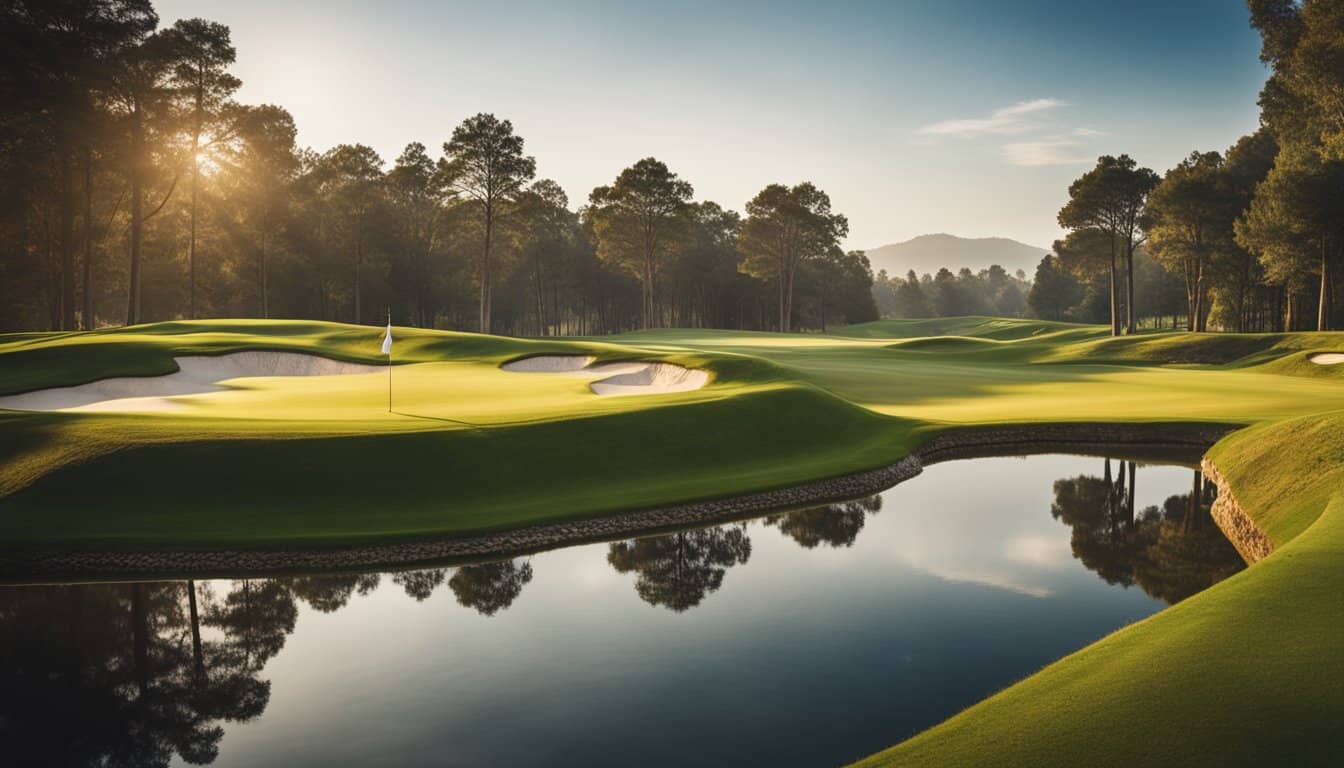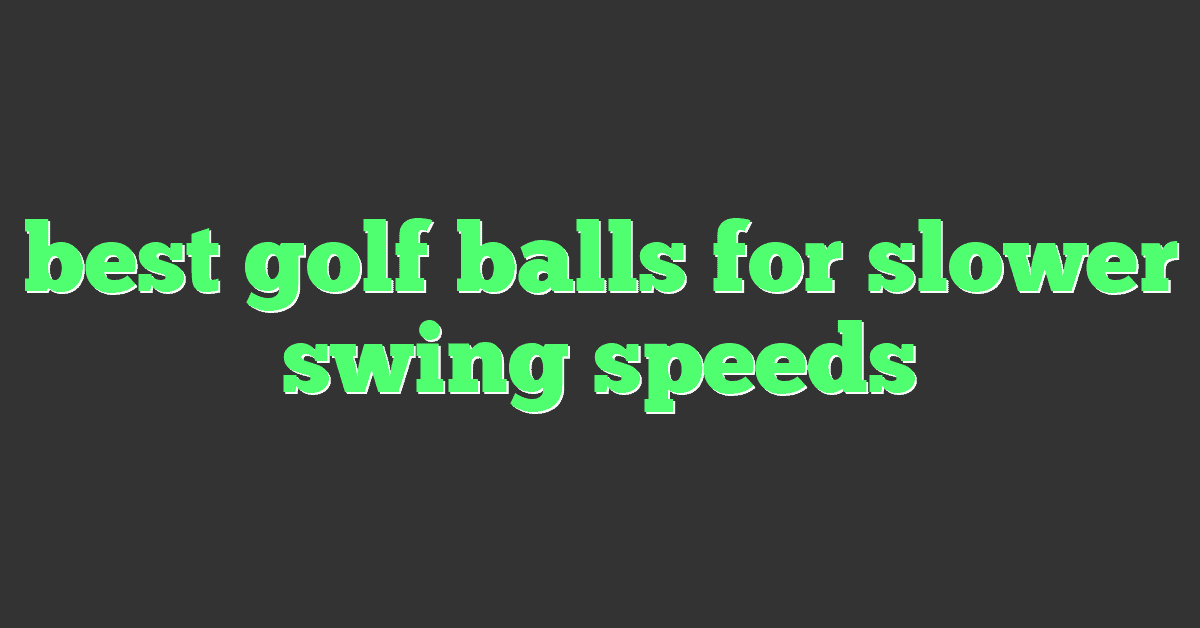If you’re new to golf, you might be wondering which golf ball is best for you. With so many options available, it can be overwhelming to choose the right one. The truth is, there’s no one-size-fits-all answer to this question. The best golf ball for you will depend on your skill level, swing speed, and personal preferences.

Understanding Golf Ball Basics is the first step in choosing the right ball for your game. Golf balls are made up of several layers, including the core, mantle, and cover. Each layer affects the ball’s performance in different ways. For example, a ball with a soft core will produce more spin and feel softer off the clubface, while a ball with a hard core will produce less spin and feel harder.
When it comes to choosing the right golf ball for beginners, there are several factors to consider. Top Golf Balls for Beginners include those that offer a soft feel, good distance, and forgiveness. Price vs. Performance is another important consideration. While more expensive balls may offer better performance, they may not be worth the extra cost for a beginner golfer. Golf Ball Features Explained can help you understand the different features and technologies that are available in golf balls today. By taking the time to research and compare different options, you can find the best golf ball for your game and start improving your score on the course.
Key Takeaways
- Choosing the right golf ball for your game depends on your skill level, swing speed, and personal preferences.
- Top golf balls for beginners offer a soft feel, good distance, and forgiveness.
- Price vs. performance is an important consideration when choosing a golf ball.
Understanding Golf Ball Basics
https://www.youtube.com/watch?v=4_8t0Nesqoc&embed=true
If you’re a beginner in golf, choosing the right golf ball can be overwhelming. There are various types of golf balls available in the market, each with different features and benefits. In this section, we’ll help you understand the basics of golf balls, so you can make an informed decision when choosing the right golf ball for you.
Construction and Design
Golf balls are constructed with different layers, each designed to provide specific benefits. The most common golf balls are two-piece, three-piece, and four-piece golf balls. Two-piece golf balls are the most popular among beginners due to their durability and distance. They have a large solid core and a hard cover, making them ideal for golfers with a slower swing speed.
Three-piece golf balls have a softer core, which provides more spin and control, making them suitable for golfers with a faster swing speed. Four-piece golf balls have an extra layer between the core and cover, providing even more spin and control.
The dimple pattern on the surface of the golf ball also plays a significant role in the ball’s performance. The dimples create turbulence in the air, reducing drag and increasing lift, resulting in a longer distance.
Types of Golf Balls
There are different types of golf balls available in the market, each designed for specific purposes. Distance golf balls are ideal for beginners who want to achieve maximum distance. These golf balls have a hard outer layer and a large solid core, making them travel farther.
On the other hand, spin golf balls are designed for golfers who want more control over their shots. These golf balls have a softer outer layer and a softer core, providing more spin and control.
Lastly, there are also soft compression golf balls that are designed for golfers with slower swing speeds. These golf balls have a lower compression rate, making them easier to compress and travel farther, even with a slower swing speed.
Understanding the basics of golf balls is crucial in choosing the right golf ball for your game. Consider your swing speed, playing style, and the golf course you’ll be playing on when choosing a golf ball.
Choosing the Right Golf Ball for Your Game
https://www.youtube.com/watch?v=r-CPeR4ei_8&embed=true
As a beginner, choosing the right golf ball can be overwhelming with so many options available in the market. However, selecting the right ball is crucial to improve your game and lower your handicap. In this section, we will discuss the factors you need to consider when selecting the best golf ball for your game.
Compression and Swing Speed
The compression rating of a golf ball is a measure of how much the ball compresses when it is struck. Golf balls with a lower compression rating are softer and compress more, making them ideal for golfers with slower swing speeds. On the other hand, golf balls with higher compression ratings are harder and compress less, making them suitable for golfers with faster swing speeds.
If you have a slower swing speed, you should consider using a golf ball with a lower compression rating. These balls will compress more and create more energy, resulting in a longer shot. However, if you have a faster swing speed, you should consider using a golf ball with a higher compression rating. These balls will compress less and create less spin, resulting in a more accurate shot.
Spin and Distance
The spin rate of a golf ball is another crucial factor to consider when selecting the right golf ball for your game. Golf balls with a higher spin rate will create more backspin, resulting in a higher trajectory and more distance. However, these balls are more difficult to control, and if you have a slice or hook, they can make it worse.
On the other hand, golf balls with a lower spin rate will create less backspin, resulting in a lower trajectory and less distance. However, these balls are more forgiving and easier to control, making them ideal for beginners.
In summary, when choosing the right golf ball for your game, you need to consider your swing speed, compression, spin, and distance. By selecting the right ball, you can improve your game and lower your handicap.
Top Golf Balls for Beginners
https://www.youtube.com/watch?v=TfHHwOq3wcI&embed=true

« How to Hit Down on the Golf Ball for Better Shots
How to Prevent Hitting a Golf Ball Fat: Tips and Tricks »
If you’re just starting out in golf, choosing the right ball can be overwhelming. There are so many options available, and it can be hard to know which one is right for you. In this section, we’ll take a look at two of the best golf balls for beginners: the Titleist TruFeel and the Callaway Supersoft.
Titleist TruFeel
The Titleist TruFeel is a great all-around ball for beginners. It has a soft feel, which makes it easier to control around the greens. It also has good distance off the tee, so you can hit it far even if you don’t have a lot of swing speed.
One of the best things about the TruFeel is its price. It’s one of the most affordable balls on the market, which is great if you’re just starting out and don’t want to spend a lot of money on golf balls.
Callaway Supersoft
The Callaway Supersoft is another great option for beginners. It’s designed to be forgiving, which means that even if you don’t hit it perfectly, it will still go straight and far.
The Supersoft is also very soft, which makes it easy to control around the greens. It has a low compression core, which means that it will compress more on impact, giving you more distance even if you don’t have a lot of swing speed.

In addition, the Supersoft has a great feel off the clubface. It’s very responsive, which means that you’ll be able to feel the ball as soon as you hit it.
Overall, both the Titleist TruFeel and the Callaway Supersoft are excellent options for beginners. They’re both affordable, forgiving, and easy to control, which makes them perfect for new golfers who are still learning the game.
Price vs. Performance
https://www.youtube.com/watch?v=zrBaLDYrBvI&embed=true
When it comes to choosing the right golf ball for beginners, price and performance are two important factors to consider. You want to find a ball that offers good value for your money without sacrificing performance on the course. Here are some things to keep in mind when weighing price against performance.
Budget-Friendly Options
If you’re on a tight budget, there are plenty of affordable golf balls that can still provide good performance. Look for balls that offer a good balance of distance, control, and feel. Some popular budget-friendly options include the Top Flite XL Distance and the Wilson Ultra 500 Distance. These balls are often sold in bulk, which can help bring down the cost per ball.

Another option is to look for recycled or refurbished golf balls. These balls have been used but have been cleaned and restored to like-new condition. They are often sold at a fraction of the cost of new balls and can still offer good performance on the course.
Premium Ball Considerations
If you’re willing to spend a little more money, premium golf balls can offer even better performance. These balls are often designed with advanced technology and materials that can provide more distance, spin, and control. Some popular premium ball options include the Titleist Pro V1, Callaway Chrome Soft, and TaylorMade TP5.
However, it’s important to keep in mind that premium balls can come with a higher price tag. If you’re a beginner, you may not see a significant difference in performance between a premium ball and a more affordable option. It’s also worth noting that premium balls can be more easily lost on the course, which can add up in cost over time.
Ultimately, the right golf ball for you will depend on your budget and your performance needs. By weighing price against performance, you can find a ball that offers good value without sacrificing your game on the course.
Golf Ball Features Explained
https://www.youtube.com/watch?v=pMh7k6tHtEQ&embed=true
When it comes to choosing the right golf ball, there are a few key features to consider. These features can affect the ball’s performance and your overall game. Here are some of the most important features to keep in mind:
Dimples and Aerodynamics
One of the most important features of a golf ball is its dimples. Dimples help to reduce drag and improve the ball’s aerodynamics, allowing it to travel farther and with more accuracy. The number and pattern of dimples can vary between different types of golf balls.
A golf ball with more dimples will generally have better aerodynamics and travel farther than a ball with fewer dimples. However, a ball with too many dimples can be more difficult to control, especially for beginners.
Core and Cover Materials
The materials used in the core and cover of a golf ball can also affect its performance. Most golf balls have a core made of either rubber or resin. Rubber cores are generally softer and provide more spin, while resin cores are firmer and provide more distance.
The cover of a golf ball can be made of either urethane or ionomer. Urethane covers are softer and provide more spin, while ionomer covers are firmer and provide more distance.

For beginners, it’s generally best to choose a golf ball with a soft cover and a low compression core. This will provide more spin and control, making it easier to hit the ball accurately. As you improve your game, you can experiment with different types of golf balls to find the one that works best for you.
Overall, choosing the right golf ball can make a big difference in your game. By considering the features of the ball, such as dimples, core and cover materials, you can find the perfect ball to improve your performance on the course.
Improving Your Game with the Right Ball
Choosing the right golf ball for your game can be a game-changer. As a beginner, it’s important to understand how different golf balls can affect your game. In this section, we’ll discuss how the right ball can improve your control and feel, as well as your launch and trajectory.
Control and Feel
Control and feel are important aspects of any golf game, especially for beginners. A golf ball with a soft cover will give you more feel and control around the greens, allowing you to better judge the distance and direction of your shots. Some great options for soft cover golf balls include the Titleist TruFeel and the Callaway Supersoft.
On the other hand, a golf ball with a harder cover will give you more distance off the tee and better control in windy conditions. If you’re looking for a ball with a harder cover, the Titleist Velocity and the TaylorMade Distance+ are both great options.

Launch and Trajectory
The launch and trajectory of your shots are also important factors to consider when choosing a golf ball. If you struggle with getting enough height on your shots, a golf ball with a low compression rating can help you achieve a higher launch angle. The Srixon Soft Feel and the Wilson Staff Fifty Elite are both great options for golfers looking for a ball with a low compression rating.
If you’re looking for a ball that will help you achieve a lower ball flight, a golf ball with a high compression rating may be the way to go. The Titleist Pro V1 and the Bridgestone Tour B X are both great options for golfers looking for a ball with a high compression rating.
Remember, the right golf ball can make all the difference in your game. By considering factors such as control, feel, launch, and trajectory, you can choose a ball that will help you improve your game and have more fun on the course.
Golf Equipment Essentials for Beginners
When you’re just starting out with golf, it can be overwhelming to figure out what you need to get started. Here are some golf equipment essentials for beginners to help you get started on the right foot.
Selecting Golf Clubs
The most important piece of equipment in your golf bag is, of course, your clubs. As a beginner, you don’t need to invest in the most expensive clubs on the market. Instead, focus on finding a set of clubs that are comfortable for you to use and fit your swing style.

There are a few things to keep in mind when selecting your clubs. First, make sure you have a driver, a fairway wood, a hybrid, some irons, and a putter. You can always add more clubs to your bag as you become more experienced.
Second, consider the shaft flex of your clubs. Generally, beginners should choose clubs with a more flexible shaft. This will help you generate more clubhead speed and get more distance on your shots.
Finally, make sure you get the right size clubs for your height. If you’re unsure what size clubs you need, ask a professional at your local golf store for help.
Accessorizing Your Golf Bag
Once you have your clubs, you’ll need a golf bag to carry them in. Look for a bag that has enough pockets to hold all of your accessories, such as tees, balls, and gloves.
When it comes to accessories, there are a few things that are essential for beginners. First, you’ll need golf balls. As a beginner, you don’t need to invest in the most expensive balls on the market. Instead, look for balls that are designed for beginners, such as the Titleist Trufeel Golf Ball or the Callaway Supersoft Golf Ball.
You’ll also need tees, which are used to prop the ball up off the ground for your tee shots. Look for tees that are the right height for your driver and other clubs.
Finally, consider investing in a golf glove. Gloves can help you get a better grip on your clubs and prevent blisters. Look for a glove that fits well and is made from a breathable material.
By selecting the right clubs and accessories, you can set yourself up for success on the golf course. With a little practice and patience, you’ll be hitting great shots in no time!
Common Questions Answered
FAQs for Beginner Golfers
If you’re new to the game of golf, you probably have a lot of questions. Here are some of the most common FAQs for beginner golfers:
What golf ball should I use as a beginner?
As a beginner, you should look for a golf ball that is designed to help you improve your game. Look for a ball that is designed for beginners, such as the Titleist Trufeel Golf Ball or the Callaway Supersoft Golf Ball. These balls are designed to provide maximum distance and accuracy, and they are also very forgiving.

What is the difference between a golf ball for beginners and a golf ball for professionals?
The main difference between a golf ball for beginners and a golf ball for professionals is the construction of the ball. A golf ball for beginners is designed to provide maximum distance and accuracy, while a golf ball for professionals is designed to provide maximum spin and control.
How many golf balls should I buy as a beginner?
As a beginner, you should buy at least a dozen golf balls. This will give you enough balls to practice with, and it will also give you a good idea of which ball works best for you.
Should I buy used golf balls as a beginner?
While used golf balls may be cheaper than new golf balls, they may not be the best choice for a beginner. Used golf balls may have scuffs or other imperfections that can affect their performance. It’s best to stick with new golf balls as a beginner.
Expert Tips and Advice
If you’re looking to improve your golf game, here are some expert tips and advice:
Focus on your short game
The short game is one of the most important aspects of golf, so it’s important to focus on it as a beginner. Spend time practicing your putting, chipping, and pitching.

Work on your swing
Your swing is the foundation of your golf game, so it’s important to work on it as much as possible. Spend time practicing your swing, and consider taking lessons from a golf professional.
Develop good habits
Developing good habits early on can help you improve your golf game quickly. Make sure to practice regularly, and focus on developing good posture and a consistent swing.
Don’t get discouraged
Golf is a difficult game, and it can be frustrating at times. Don’t get discouraged if you don’t see immediate improvement. Stick with it, and you’ll see results over time.
Brands and Manufacturers
Finding Brand Loyalty
When it comes to golf balls, there are a few brands that have dominated the market for many years. Titleist, TaylorMade, Callaway, and Srixon are just a few of the top manufacturers that come to mind. But as a beginner, you may not know which brand to choose. One way to narrow down your options is to test out a few different brands and see which one feels the most comfortable to you.
Another way to determine which brand is right for you is to ask other golfers for their opinion. Many golfers have brand loyalty and will swear by a particular brand of golf ball. If you have friends or family members who golf, ask them which brand they prefer and why. You can also ask employees at your local golf store for their recommendations.

Exploring Different Manufacturers
While Titleist, TaylorMade, Callaway, and Srixon are some of the most popular golf ball manufacturers, there are many other brands to consider as well. Some lesser-known brands may offer golf balls that are better suited for beginners.
When exploring different manufacturers, it’s important to consider factors such as price, distance, and feel. Some golf balls may be more expensive than others, but they may also offer better performance. Other golf balls may be more forgiving and easier to hit for beginners.
Ultimately, the best way to determine which golf ball is right for you is to test out a few different brands and models. Take note of how each golf ball feels when you hit it and how it performs on the course. With a little trial and error, you’ll be able to find the perfect golf ball to help improve your game.
Playing the Course
As a beginner, playing the course can be a daunting task. However, with the right golf ball and a bit of practice, you can become confident navigating fairways and greens and avoiding hazards.
Navigating Fairways and Greens
When it comes to navigating fairways and greens, accuracy is key. You want to aim for the center of the fairway and avoid hitting into trees or other obstacles. One way to improve your accuracy is to choose a golf ball that suits your swing speed and style. For example, a softer ball like the Titleist TruFeel or Callaway Supersoft can help beginners achieve more distance and accuracy off the tee.
Once you’re on the fairway, you’ll want to focus on hitting the ball straight and avoiding any hazards like bunkers or water. A good strategy is to aim for the center of the green and avoid hitting towards any hazards. This will help you stay on track and avoid any unnecessary strokes.
Avoiding Hazards
Hazards like bunkers, water, and trees can be intimidating for beginners. However, with the right approach, you can avoid them and keep your score low. When it comes to bunkers, you’ll want to focus on hitting the ball out cleanly and onto the green. One way to achieve this is to use a higher lofted club like a sand wedge and aim for the center of the bunker.
Water hazards can be tricky, but with the right ball, you can minimize the risk of losing your ball. A ball like the Bridgestone e6 or Srixon AD333 offers good distance and accuracy, making it easier to avoid water hazards and stay on course.
Lastly, trees can be a common obstacle on the course. If you find yourself hitting towards a tree, try to aim for a gap or opening in the branches. This will help you avoid getting stuck in the tree and keep your ball in play.
In conclusion, playing the course as a beginner can be challenging, but with the right golf ball and strategy, you can navigate fairways and greens and avoid hazards. Remember to choose a ball that suits your swing speed and style, focus on accuracy, and stay calm and confident on the course.










